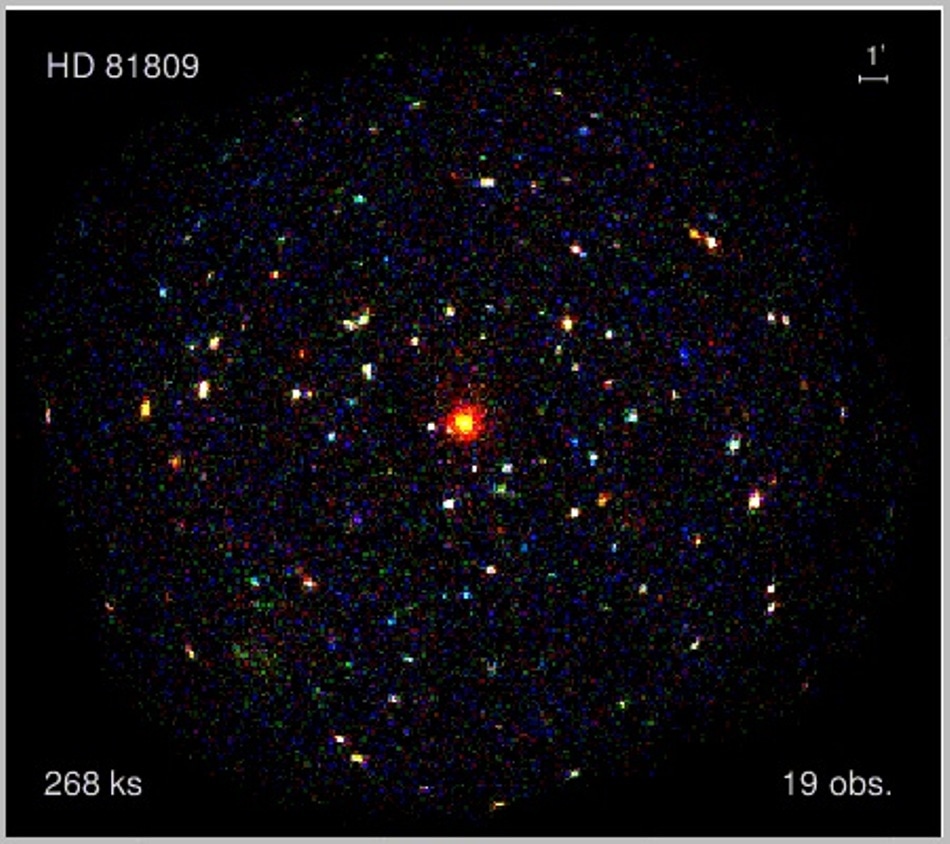Jul 27 2018
Members of the X-ray astronomy working group at the Leibniz Institute for Astrophysics (AIP) have collaborated with an international group of researchers and published the first catalogue of X-ray sources in multiply observed sky regions.
 Nineteen superimposed XMM-Newton observations of the same sky region. This corresponds to an exposure time of more than three days. (Image credit: AIP)
Nineteen superimposed XMM-Newton observations of the same sky region. This corresponds to an exposure time of more than three days. (Image credit: AIP)
The catalogue includes nearly 72,000 objects, of partially exotic nature, which were observed using the space-based X-ray telescope XMM-Newton. It gives information related to the physical characteristics of the sources and allows astronomers to recognize brightness variations on time scales of a number of years - and consists of several thousand new detections.
“The more images are superimposed the more details become visible”
From the time it was launched at end of 1999, the European X-ray satellite XMM-Newton has observed various patches of the sky in a repeated manner. Members of the X-ray astronomy group have created innovative software to look for astrophysical objects in overlapping observations and employed it to compile the first catalogue. Combining multiple observations of the same region of sky enables achieving higher accuracy and observing faint sources that are otherwise undetectable in the individual observations. “Our method is similar to combining several transparencies showing the same subject: The more images are superimposed the more details become visible,” explained Dr Iris Traulsen, the project scientist at the AIP.
The new catalogue includes 71,951 X-ray sources in 1789 XMM-Newton observations and lists abundant information on their physical properties. Several thousand of these sources have been newly discovered, among which many are very faint and challenging to detect. The catalogue can be used to detect variations in brightness of X-ray sources over time scales of up to 14.5 years. According to Dr Axel Schwope, team leader at the AIP, “Variations of the X-ray brightness are essential criteria used to search for exotic Celestial objects. To decipher their nature, we also employ the Large Binocular Telescope (LBT) in Arizona.” The AIP is one of the LBT partners and contributes to its instrumentation and software.
Researchers across the globe have been employing the XMM-Newton Source Catalogues to obtain new information related their research objects and to look for rare and as yet unknown X-ray sources.
X-Ray Telescopes: the Invisible Made Visible
X-ray observations open the door for regions of the Universe that are hidden from human eyes. Celestial X-rays are produced by highly energetic processes, for instance, in hot gas at temperatures of hundreds of millions degrees. This comparatively new method has been used for nearly 50 years to examine these often exotic objects. ESA’s space-based X-ray telescope XMM-Newton can cover the same sky area as the full moon in a single observation and includes 50–100 X-ray sources. These sources range from very compact or hot, collapsed stars to massive black holes in faraway galaxies and to galaxy clusters located billions of light years from the Earth.
The XMM-Newton Survey Science Centre Consortium was established over 20 years ago as a group of researchers in a number of European countries, including France, Spain, the United Kingdom, and Germany. They process the publicly available XMM-Newton observations and publish catalogues of all serendipitously detected X-ray sources. The source-detection software is contributed and maintained by the AIP.